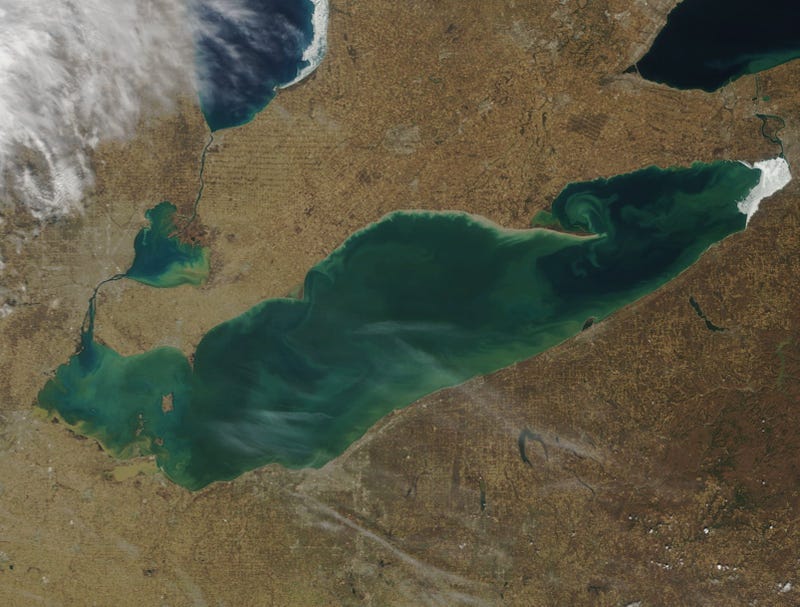
Buffalo, N.Y. (WBEN) - Spring has finally sprung in Western New York, as people look ahead to the warmer weather that will soon be on its way. However, that doesn't mean that the region is out of the woods just yet with winter weather this year.

"Right now, it's too early to determine exactly how much snow we'll receive over the remainder of the snow season," said National Weather Service meteorologist Dan Kelly on Monday. "However, the 6-10-day temperature outlook is showing a higher probability of below normal temperatures. So that's looking at March 26 through the 30th. So basically, the end of the month, looking at below normal temperatures for that period."
With the temperatures trending to be below average for this time of year, if they dip below the freezing mark, that could generate some more lake effect snow showers. This is especially the case with a majority of Lake Erie now exposed with most of the ice cover melted away.
"Looks like the ice is confined to the extreme Eastern portion of the lake," Kelly said. "Basically, just along Erie County a little bit, into the deeper waters. But West of that, it looks pretty much open.
"Looking at just an estimate, there's maybe 10-15% of the lake with ice on it. With the warmer temperatures, those will really start eroding away at that ice cover fairly quickly."
While there's still the chance for some wintry weather as spring starts to bloom, the ice on the lake is still expected to melt away over the coming days. As the ice coverage continues to dwindle away, we'll likely see the ice boom on Lake Erie start to be taken down for the season.
"It will be soon. I don't have an exact date yet," said Lou Paonessa from the New York Power Authority (NYPA). "The International Joint Commission basically tells the New York Power Authority when it's time to remove the ice boom. There are some criteria that are used. Basically, the boom should come out every year by April 1, unless there are more than 250 square miles on this Eastern end of the lake. As of right now, there still is quite a bit more than that. Mother Nature is doing its best to melt the ice that is out there and get it down to that threshold, but as of this past weekend, we are probably in the 750 square mile range. We did lose some over the weekend, but it's probably a week or so before we'll have a better idea.
"Not knowing the long-term forecast and everything, but Environment Canada and U.S. Army Corps of Engineers work with NYPA and the Niagara Border Control, and they monitor it pretty regularly. They'll be looking for signs that we're getting close to 250 square miles, and at that point, NYPA will start getting the crews ready to do the removal process."
Each year since 1964, an ice boom has been installed at the Eastern end of Lake Erie to reduce the frequency and duration of ice that could travel down and choke the Niagara River. That would result in the obstruction of power production on both the U.S. and Canadian side of the border, and could also cause flood damage along each side.
"What the boom does is it helps Mother Nature create a stable ice blockage at the lake, so that all frequency and duration of those ice blockages occurring in the river don't happen," Paonessa explained.
According to the International Joint Commission, the ice boom consists of 22 spans, with the first four being located between Buffalo Harbor’s inner and outer breakwater, and constructed using 16, 15-foot-long mini pontoons. The remainder of the boom is constructed using a series of steel pontoons each 30-feet-long and 30 inches in diameter.
Each span is built using up to 10 pontoons anchored to the bottom of the lake. When in position, the 8,800-foot ice boom stretches across the outlet of Lake Erie, just southwest of Buffalo’s water intake crib.
As Paonessa explains, the ice boom is installed every year in stages, and it is also removed every year in stages.
"When we talk about the actual removal, we're talking about taking it off of Lake Erie," Paonessa said. "What will happen is we'll have crews go out there and make disconnects, and tow the spans - they're 500-foot spans - to the break wall, store them there temporarily until we get all the 22 spans off of the lake. Then from that point, we will tow them up the Buffalo River to our storage site. That whole process is weather dependent. It can take a couple of weeks, usually several days to remove the boom from the lake, depending on how much ice is still behind it, whether or not you know there are pieces frozen in place.
"If the weather's great, it may go faster. But it'll be just a few days, depending on the weather and depending on the ice when it comes off the lake itself."
Back in February of 2019, a larger 30-foot section of the ice boom - about a 3,500-pound steel cylinder - had broken free at some point at the end of winter. That large section floated down the Niagara River, made its way through the American Rapids and ended up by the Bridal Veil Falls in Niagara Falls.
That chunk of the ice boom was then secured by a Swiftwater Rescue Team from the New York State Parks Police to one of the trees on Bird Island, so it wouldn't pose a danger to anyone with the Cave of the Winds sitting below the falls.
Plans were originally made this week for the State Parks Police to work in conjunction with the New York Army National Guard to remove the massive steel pontoon from the waters, but those plans were nixed due to the amount of ice buildup in that area over the weekend.
As Paonessa explains, in this particular case with the ice boom, one of those pontoons simply broke off the chain like a charm falling off a charm bracelet.
"The bracelet stays intact, but maybe one of the charms fall off. That would be the best way I could tell you is when a steel pontoon comes off, it's like a charm coming off the charm bracelet. So it's not like the boom didn't work as intended, we just lost the charm," Paonessa said. "In this particular case in February 2019, we had some really high winds and when you have a lot of ice behind the boom, and you have that kind of pressure, ice is designed to go over top of the boom. In this particular case, it took one of the pontoons with it, and became lodged above Niagara Falls. We were going to try and get it out of there with some help to, basically, preserve the viewshed of Niagara Falls."
One of the people that will oversee this mission to, eventually, remove the steel pontoon from the rapids above the Bridal Veil Falls is State Parks Police Captain Chris Rola. He says there were always plans to remove the pontoon from the rapids, but there were a number of factors that got in the way.
"We didn't want to remove it in the summertime in 2019. Just because it's so busy, and it would shut park operations down in the summer when you get nine million people is tough. It's really not fair to the public, it didn't pose a danger to anybody. Then COVID happened," Rola said on Monday after the planned mission was canceled. "There's all kinds of other agencies - NYPA is involved. To pick something up like that, you need a substantial helicopter like a Chinook helicopter. That's what we were going to hopefully use [Tuesday], but that's postponed for right now. The New York Army National Guard out of Rochester, they have those capabilities, but with COVID and everything, that didn't happen. So we finally got back to re-visiting that and getting a plan set up early this year."
As for Monday's mission, Rola says ice is the unknown factor that will put off plans until further notice. While the weather certainly can play into the ability to carry out this mission, Rola acknowledges it's easier to forecast the weather and make better plans. However, when ice becomes an issue, that makes the objective that much more difficult.
"[With] the wind pushing [the ice] over there, that changes that," Rola explained. "Then it's up to when NYPA decides, 'Hey, we're going to pull that ice boom.' We're getting close to that time. I know it's April 1 when they start to either remove it, or assess, 'Hey, we need to leave it in longer because of this buildup.' We'll have a multi-agency call, because they've always been part of it. Obviously, it's their section ice boom here, but we'll have that call either later today or tomorrow. I know we're still working on that, but once we decide when that's going to be, then we can decide moving forward."
Rola says when they did a scene assessment last week, there was no ice at all in that area of the rapids. He figures all the ice probably came with the winds late Saturday that pushed it over the top of the the ice boom.
As for the mission itself, Rola says it's likely going to be a two-day operation to successfully remove the pontoon.
"The plan would be send that rescuer out there, then we'll have another Swiftwater member join them on Bird Island. What they'll do is they were going to go out [Monday] and check the pontoon to make sure that everything's good. Those two hooks that are on the top, that's what the helicopter is going to hook to. But we have to make sure they're still good, they're in good shape, this thing's good to be lifted up. So we had secured it in 2019 with a 40,000-pound tow rope that we use on our jet boat at the brink of the falls, they pull boats or whatever. It's a very good, made to be in the water line that's out there. So that would be something that we wanted to check too when we're out there.
"The day of the operation, which would have been [Tuesday], this Chinook helicopter was going to come in and do a hover over the site. It's obviously a big helicopter, and it's got a huge rotor wash compared to any other helicopter. ... This is going to be even more, because it has those two big propellers on it. The Army National Guard said it's about a 300-foot area that you're going to get the effects from it. So the day that helicopter comes out, they're going to hover over it, just try to knock down any trees or any brush. They were going to land, we were going to have a quick briefing, then our Swiftwater members we're going to go across that line that we had set up the day prior to, there'll be three of them that go out to Bird Island, in the area of the pontoon. Two of the members of will go out into the water, the helicopter will come in, hover over, and they're going to hook two points of contact. So we'll have those two members in there, and they're going to hook to that pontoon, and then the pontoon will lift up."
Once they hoist the pontoon up, the helicopter will fly it over the vehicle bridge and pedestrian bridge, and leave it in Lot 3 of the parking lot, where NYPA will eventually remove it by vehicle.
Rola says they may have to wait until next week now to get their next chance to remove the pontoon from the rapids above the Bridal Veil Falls.
